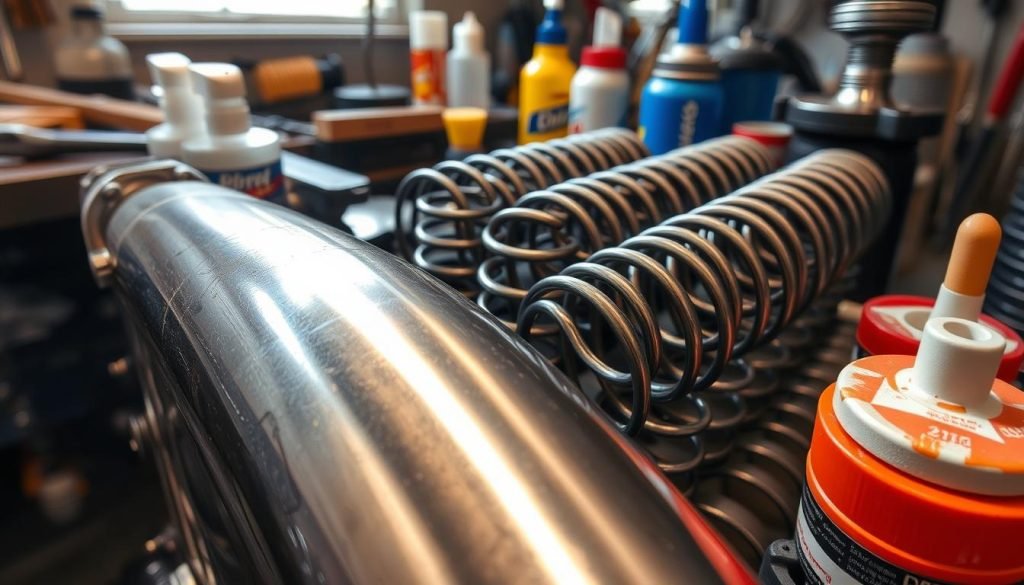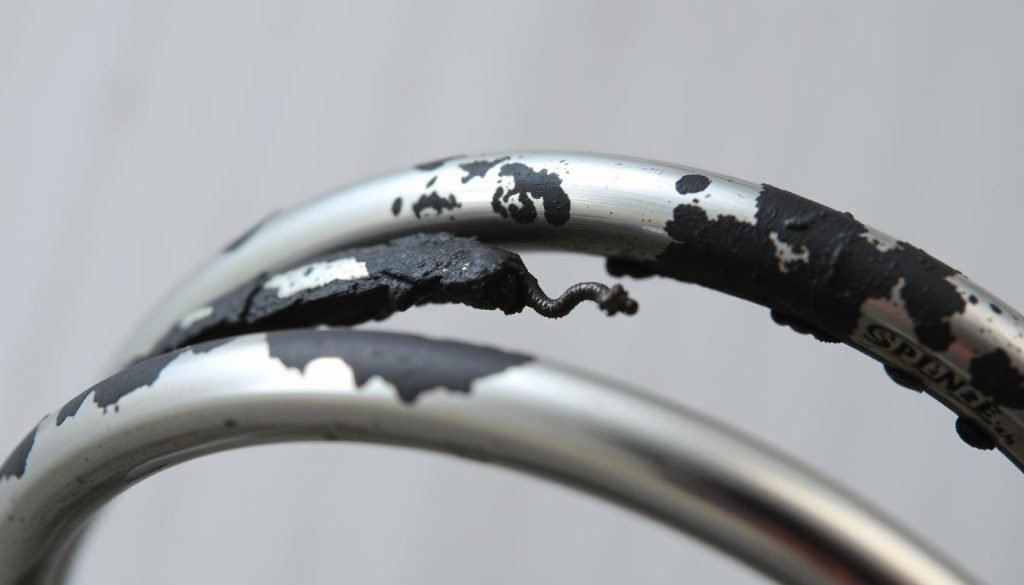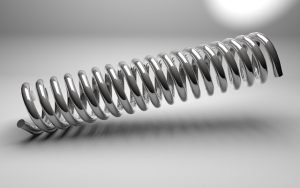Stainless steel springs are widely used in many industries. They are known for their strength, resistance to corrosion, and long life. However, they can sometimes develop black oxide coatings. This not only makes the spring look bad but can also shorten its life and affect how well it works.
In this detailed guide, we will look at why black oxide forms on stainless steel springs. We will also share ways to fix these problems.
Understanding Black Oxide on Stainless Steel Springs
Black oxide is a protective coating for stainless steel springs. It boosts their resistance to corrosion and looks good. This coating forms through a controlled oxidation process, creating a thin, durable iron oxide layer on the steel’s surface. Knowing about black oxide and how it forms is key to keeping stainless steel springs in top shape.
What is Black Oxide?
Black oxide is a conversion coating made by heating stainless steel in an alkaline solution. This heat and solution cause the iron in the steel to react with oxygen. This reaction creates a black, magnetite-based layer on the surface. This layer not only looks great but also protects the metal from corrosion and wear.
Causes of Black Oxide Formation
Several factors can influence black oxide formation on stainless steel springs. These include the steel’s composition, how it’s made, and its environment. Common causes include:
- Improper surface preparation, like not cleaning well before applying black oxide
- Being exposed to high temperatures or harsh chemicals during making or use
- Contaminated black oxide solution or poor process control during application
- Mechanical wear or abrasion, which can damage the protective oxide layer
| Factors Influencing Black Oxide Formation | Impact on Black Oxide |
|---|---|
| Surface Preparation | Bad cleaning can lead to an uneven or incomplete oxide layer |
| Manufacturing Processes | High temperatures or chemicals can speed up oxide growth or change color |
| Operating Environment | Corrosive or abrasive conditions can wear down the oxide layer over time |
Understanding why black oxide forms helps manufacturers and users of stainless steel springs. They can take steps to prevent these issues. This ensures their components last longer and look better.
“The key to managing black oxide on stainless steel springs is to proactively address the underlying causes, rather than simply treating the symptoms.”
Common Problems with Black Oxide on Stainless Springs
Black oxide coatings can offer some protection against corrosion for stainless steel springs. Yet, they can also cause several issues. It’s important to know these problems with black oxide on stainless spring to keep your components working well for a long time.
One major problem with black oxide on stainless is it might not protect as well as expected. The black oxide layer can sometimes make the stainless steel more prone to rust. This can cause rust or pitting, especially in wet or chemical-rich environments.
Another issue is the black oxide finish might look uneven. Differences in thickness, texture, or color can make the finish look mottled. This can be a problem if looks are important in your application.
Lastly, the black oxide layer can lead to springs wearing out faster. The coating might flake off or chip, exposing the metal underneath. This can weaken the spring and affect its performance.
| Problem | Potential Impact |
|---|---|
| Reduced Corrosion Resistance | Increased risk of rusting, pitting, and premature failure |
| Inconsistent Appearance | Unacceptable aesthetics, especially in high-visibility applications |
| Premature Wear or Failure | Compromised integrity and performance of the stainless steel springs |
Knowing these common problems with black oxide on stainless spring is the first step to finding solutions. This ensures your stainless steel spring components last longer and work better.
Preventing Black Oxide Formation on Stainless Springs
Stainless steel springs are known for their strength and resistance to corrosion. But, preventing black oxide formation can be tricky. Luckily, there are ways to stop this problem and improve how springs are made.
Proper Material Selection
Choosing the right stainless steel alloy is key to avoiding black oxide. Grades like 304 and 316 are better at resisting oxide formation. Choosing the right grade for your needs can greatly improve the springs’ performance over time.
Optimizing Manufacturing Processes
Material selection is just the start. Improving the manufacturing process also plays a big role. Here’s how:
- Proper heat treatment: The right temperature and time can stop oxide growth.
- Surface preparation: Clean and polish the spring well to stop oxide buildup.
- Coating applications: Use protective coatings like passivation or electroplating to block oxide formation.
By focusing on both material choice and process improvement, makers can stop black oxide on stainless steel springs. This ensures their products last longer and work better.
“Preventing black oxide on stainless springs requires a comprehensive approach that considers both the materials and the manufacturing processes.”
Removing Black Oxide from Stainless Springs
Stainless steel springs are durable and resistant to corrosion. But, they can get a black oxide coating over time. This coating can ruin their look and performance. Luckily, there are many ways to remove black oxide from stainless steel springs.
Mechanical Methods
One common way to remove black oxide is mechanically. This means scrubbing or blasting the surface to get rid of the oxide. Mechanical methods can make the springs shine again. But, they need to be done carefully to avoid harming the metal.
- Abrasive Blasting: This method uses compressed air or media like glass beads to remove black oxide. It’s great for big batches or parts with hard-to-reach areas.
- Polishing: Using abrasive pads or wheels can also remove black oxide. It’s good for small or delicate parts, as it’s more precise.
Chemical Methods
Chemical methods are another way to remove black oxide. They use special cleaning solutions or acids to break down the oxide. These methods can be gentle on the metal.
- Acid Dipping: Soaking springs in acidic solutions like hydrochloric or sulfuric acid can dissolve the black oxide. It’s important to watch the springs closely to avoid over-etching.
- Alkaline Cleaning: Using a high pH cleaning solution can also remove black oxide. This method is often gentler and works well for sensitive parts.
Choosing between mechanical and chemical methods depends on the project’s needs. The size, shape, and number of springs matter. Knowing the pros and cons of each method helps manufacturers make the best choice for their stainless steel parts.
problems with black oxide on stainless spring
Black oxide coatings on stainless steel springs can cause several problems. This discoloration not only looks bad but can also harm the spring’s performance and lifespan.
One major issue is the reduced corrosion resistance. The oxide layer can block the stainless steel from forming a protective film. This makes the spring more likely to corrode, especially in harsh environments or when exposed to certain chemicals.
| Problem | Impact |
|---|---|
| Inconsistent appearance | Affects the overall aesthetic of the assembly, potentially compromising the desired visual appeal. |
| Reduced corrosion resistance | Increased risk of corrosion and premature failure of the spring. |
| Premature wear or failure | The compromised integrity of the spring can lead to reduced performance and a shortened service life. |
Black oxide can also make the spring look uneven, which might not be what you want. This is especially true in industries like automotive, consumer electronics, or medical devices. Here, the look of components is very important.
In severe cases, black oxide can cause the spring to wear out or fail early. This is a big problem in critical applications where the spring’s reliability and long life are key.
To solve these issues, it’s important to know why black oxide forms and how to stop or fix it. The next parts will talk about how to prevent and remove black oxide. We’ll also cover how to keep stainless steel springs looking good and working well for a long time.
Maintaining Stainless Steel Springs
Keeping stainless steel springs in good shape is key. Regular checks and cleanings, along with the right storage and handling, are vital. These steps help ensure the springs work well for a long time.
Regular Inspection and Cleaning
Checking stainless steel springs often is the best way to stop black oxide. Look for any color changes or rust. Clean them with a soft cloth to remove dirt and stuff that can cause black oxide.
Proper Storage and Handling
Storing and handling springs right is also crucial. Keep them in a clean, dry place, away from harmful stuff. Don’t touch them with your bare hands because oils and salts can cause black oxide. Use gloves to protect the springs.
| Maintenance Recommendations | Fréquence |
|---|---|
| Visual inspection for discoloration or corrosion | Monthly |
| Cleaning with a soft, non-abrasive cloth | Quarterly |
| Storing in a clean, dry environment | Continuous |
| Handling with clean, protective gloves | Continuous |
By sticking to these maintenance tips, you can make your stainless steel springs last longer. This helps avoid black oxide problems.

Case Studies: Successful Solutions for Black Oxide Issues
Dealing with black oxide problems on stainless steel springs can be tough for manufacturers. But, the right approach can make a big difference. Let’s look at some real-world examples of successful solutions to black oxide issues.
A leading automotive parts supplier was struggling with black oxide on their stainless steel valve springs. They found the problem was in their manufacturing process. By tweaking the heat treatment and improving quality control, they fixed the issue. This kept their components looking and working great.
A medical device maker faced black oxide on their stainless steel compression springs. They used a special chemical cleaning to remove the oxide without harming the material. This fixed the look and kept their devices working well.
“Identifying the root cause and addressing it through targeted process improvements is key to overcoming black oxide challenges on stainless steel springs.”
An industrial machinery maker also had black oxide problems on their stainless steel torsion springs. They changed their material and manufacturing methods. This created a custom solution that stopped black oxide and kept their parts corrosion-resistant.
These examples show that solving black oxide problems on stainless steel springs needs a detailed look, process tweaks, and specific fixes. By using their knowledge and creative solutions, these companies beat the black oxide issue. They delivered top-notch, dependable products to their customers.

Conclusion
In this article, we’ve looked at the problems of black oxide on stainless steel springs. We’ve also talked about how to fix these issues. We’ve given you a detailed guide to keep your stainless steel parts in top shape.
Choosing the right materials and following the best manufacturing and care methods can help. This way, you can avoid black oxide and make sure your springs last a long time. The examples and advice in this article show how these steps work. They help you deal with conclusion on black oxide issues and find solutions for black oxide on stainless springs.
Now, it’s time to put these tips into action. Always follow the best practices we’ve shared. Keep an eye on your stainless steel springs to prevent black oxide. This will protect your important parts, save money on repairs, and keep your systems running smoothly. Start using these solutions to get the most out of your stainless steel springs.
FAQ
What is black oxide and how does it form on stainless steel springs?
Black oxide is a protective coating for stainless steel springs. It forms through a controlled oxidation process. The surface of the steel is heated, creating a thin, black oxide layer.
What are the common causes of black oxide formation on stainless steel springs?
Black oxide forms due to poor manufacturing or harsh environments. Improper surface prep or heat treatment are common causes. High humidity or corrosive substances also contribute.
What are the problems associated with black oxide coatings on stainless steel springs?
Black oxide coatings can reduce corrosion resistance and look uneven. They can also wear out quickly, leading to component failure. The layer may chip or flake, harming the springs’ protection and performance.
How can manufacturers prevent the formation of black oxide on stainless steel springs?
To avoid black oxide, manufacturers should choose the right materials and optimize processes. They should also use thorough surface prep, controlled heat treatment, and high-quality coatings.
What are the methods for removing existing black oxide coatings from stainless steel springs?
Removing black oxide involves mechanical or chemical methods. Abrasive blasting or polishing are mechanical options. Chemical methods use specialized cleaning solutions or stripping agents. The choice depends on the springs’ condition and needs.
How can manufacturers maintain the quality and performance of stainless steel springs with black oxide coatings?
Keeping stainless steel springs in good shape requires regular checks and cleanings. They should be stored and handled carefully to avoid damage. Implementing preventive measures, like monitoring and reapplying coatings, is also key to their long-term reliability.






